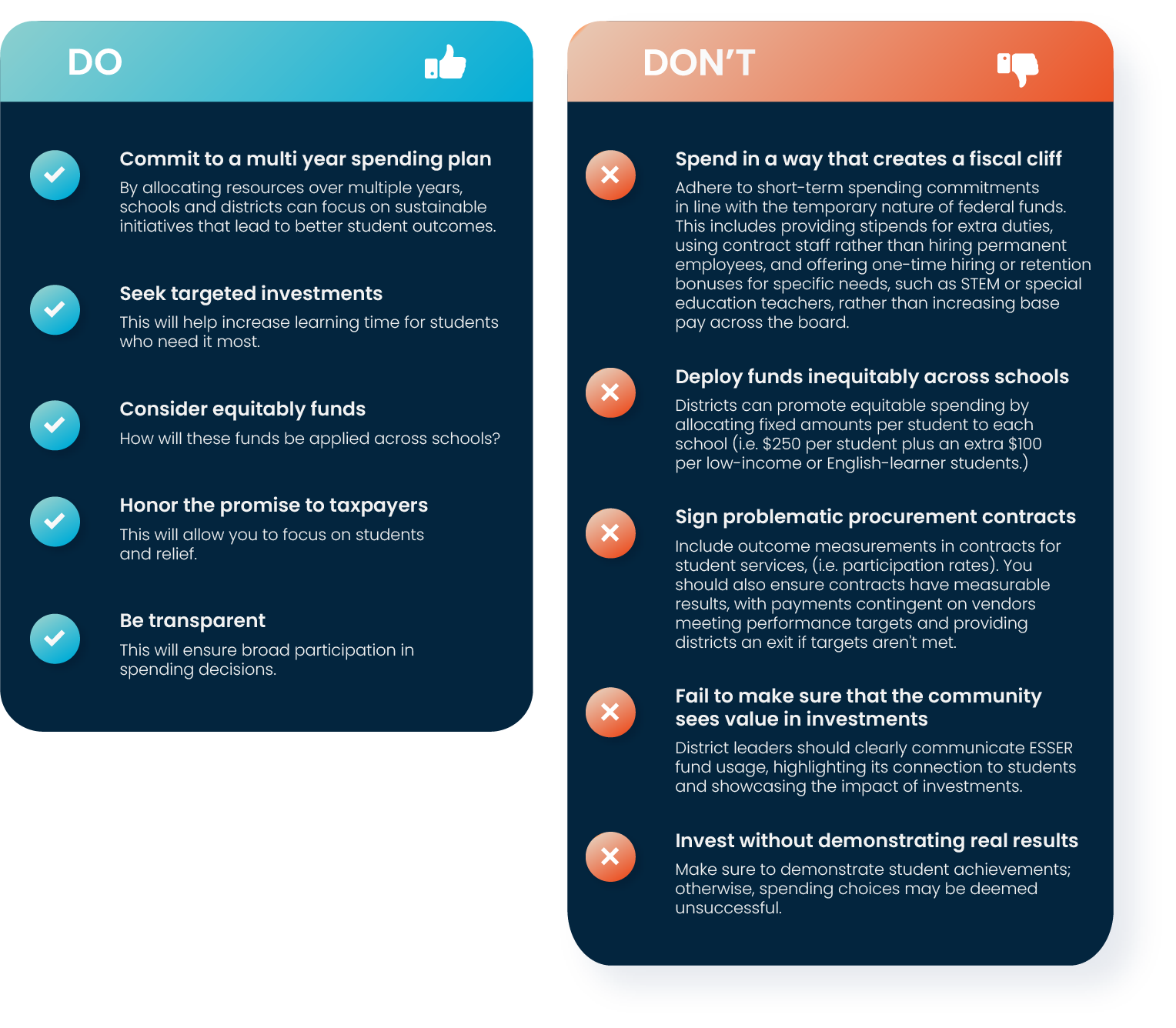From a telehealth and teletherapy programs promoting student well-being in Mississippi, and enhanced performance monitoring to help identify academically struggling students in Vermont, schools nationwide are finding creative ways to use ESSER funds to address their unique, post-pandemic needs.
ESSER has granted many schools the flexibility to introduce innovative projects. These projects aim to help students recover socially, emotionally, and academically (Allovue). While that may look different for every school, the need for long-term vision and thoughtful planning is universal.
But this funding won’t last forever: ESSER funding has an expiration date (January 21, 2025 to be exact), which means that a “fiscal cliff” lies ahead for many schools. Although schools have opted for giant one-time investments–knowing that the ESSER funding won’t be around indefinitely–there is still a threat that their ESSER programs will fall apart if not strategically budgeted for in the future.
As we move into the third round of ESSER (ESSER III), let’s ask ourselves: “How can we firmly establish these programs in a way to avoid collapse when ESSER drops off?”
Drawing from the article As ESSER Spending Ramps Up, Experts Offer Tips to Make Sure Students Truly Benefit, Now and Later, by THE Journal, we’ll explore some strategies and best practices for maximizing ESSER funding while preventing a fiscal cliff scenario.
Important ESSER Dates
The Elementary and Secondary School Emergency Relief (ESSER) Fund is a federal program designed to provide financial aid to school districts affected by the COVID-19 pandemic. The program consists of three funding rounds (so far) with their respective deadlines:
- ESSER I (13.5 Billion)
- Deadline has passed
- ESSER II ($55 Billion)
- September 30, 2023: Allocation of ESSER II Funds due
- January 31, 2024: ESSER II spending due
- ESSER III ($122 Billion)
- September 30, 2024: Allocation of ESSER III due
- January 31, 2025: ESSER III spending due
The Do’s and Don’ts of ESSER Spending and Planning
Marguerite Roza, Ph.D. (Director of Edunomics) and Chad Aldeman (former Department of Education staffer) point districts towards the “north star” for ESSER-funded initiatives: improving student outcomes.
Achieving this requires thoughtful investments and budgeting foresight. Roza and Aldeman provided a list of do’s and don’ts: their guide to five key principles and five common mistakes that district leaders should keep in mind while planning their ESSER-funded initiatives:


DON’T spend in a way that creates a fiscal cliff.
DON’T deploy funds inequitable across schools.
DON’T sign problematic contracts. Include outcome measurements in contracts for student services (ex. Participation rates). You should also ensure that contracts have measurable results, with payments contingent on vendors meeting performance targets and providing districts and exit if targets aren’t met.
DON’T invest without demonstrating real results. Make sure to demonstrate progress towards goals to avoid being deemed unsuccessful.
DON’T forget to demonstrate the value of these investments to the community. District leaders should clearly communicate ESSER fund usage, highlighting its connection to students and showcasing the impact of investment.
DO commit to a multi-year spending plan. By allocating resources over multiple years, schools and districts can focus on sustainable initiatives that lead to better student outcomes.
DO adhere to short-term spending commitments in line with the temporary nature of the funds.
DO seek targeted investments and consider equitable distribution of funds. Districts can promote equitable spending by allocating fixed amounts per student to each school (ex. $250/student plus anextra $100/low income or english-learning students)
DO honor the spirit of ESSER and its promise to the taxpayer (i.e. focus on students and relief).
DO be transparent about spending within your school, district, and community. Clearly communicate the plan to promote buy-in and encourage participation in the success of your initiative.
Budget Tips to Prevent a Post-ESSER Fiscal Cliff
If you’re struggling to balance your budget and need some tips, Discovery Education’s guide can be a great reference. They suggest that districts should be mindful of the fact that ESSER funds won’t last forever, and offer some helpful advice for managing finances accordingly. By following these guidelines, District leaders can help their districts stay on track financially and be prepared for whatever challenges may come:
Forward Funding:
Paying for multiple years of a contract upfront, can be a viable option depending on your local and state procurement rules. It creates a way to manage expenses and plan for the future.
With committing to a longer-term contract, organizations may be able to secure better rates and avoid unexpected price increases down the line.
Displace and Extend:
School boards can consider using ESSER funds to cover general expenses that occur annually. This can free up a portion of the district’s general revenue to be saved for future allocation and may be feasible depending on local and state rules, as the federal “supplement, not supplant” requirement does not apply to ESSER funds.
By using time-limited funds now and saving non-limited funds for the future, beneficial ESSER practices can be extended to post-ESSER school years.
Strategic Replacement:
Districts can use ESSER funds to invest in newer and more effective instructional technology, network infrastructure, and other necessary resources.
This approach eliminates outdated or ineffective systems and strategies and the ESSER-funded solutions can then take the place of the abandoned systems in the annual plan, ensuring that resources are being used efficiently and effectively.
Displace and Replace
The most challenging but potentially game-changing strategy is to combine the displace and expand with the strategic replacement strategies.
This approach would offer the greatest long-term sustainability and flexibility in terms of budget, but it would also require significant effort and resources to implement successfully.
By following the do’s and don’ts of ESSER spending and planning, and employing budget tips to prevent a post-ESSER fiscal cliff, districts can ensure they are making the best use of the funds to benefit their students and communities in both the short and long term.





